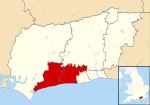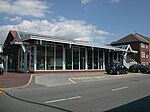Littlehampton Friends Meeting House
1965 establishments in England20th-century Quaker meeting housesChurches completed in 1836Churches in West SussexFormer school buildings in the United Kingdom ... and 5 more
Grade II listed buildings in West SussexGrade II listed religious buildings and structuresLittlehamptonQuaker meeting houses in EnglandUse British English from May 2015

Littlehampton Friends Meeting House is a Religious Society of Friends (Quaker) place of worship in the town of Littlehampton, part of the Arun district of West Sussex, England. A Quaker community has worshipped in the seaside town since the 1960s, when they acquired a former Penny School building constructed in the early 19th century. The L-shaped, flint-faced structure, consisting of schoolrooms and a schoolmaster's house, has been converted into a place of worship at which weekly meetings take place. The house is a Grade II Listed building.
Excerpt from the Wikipedia article Littlehampton Friends Meeting House (License: CC BY-SA 3.0, Authors, Images).Littlehampton Friends Meeting House
Church Street, Arun
Geographical coordinates (GPS) Address External links Nearby Places Show on map
Geographical coordinates (GPS)
| Latitude | Longitude |
|---|---|
| N 50.8097 ° | E -0.539 ° |
Address
Friends Meeting House
Church Street
BN17 5JB Arun
England, United Kingdom
Open on Google Maps







